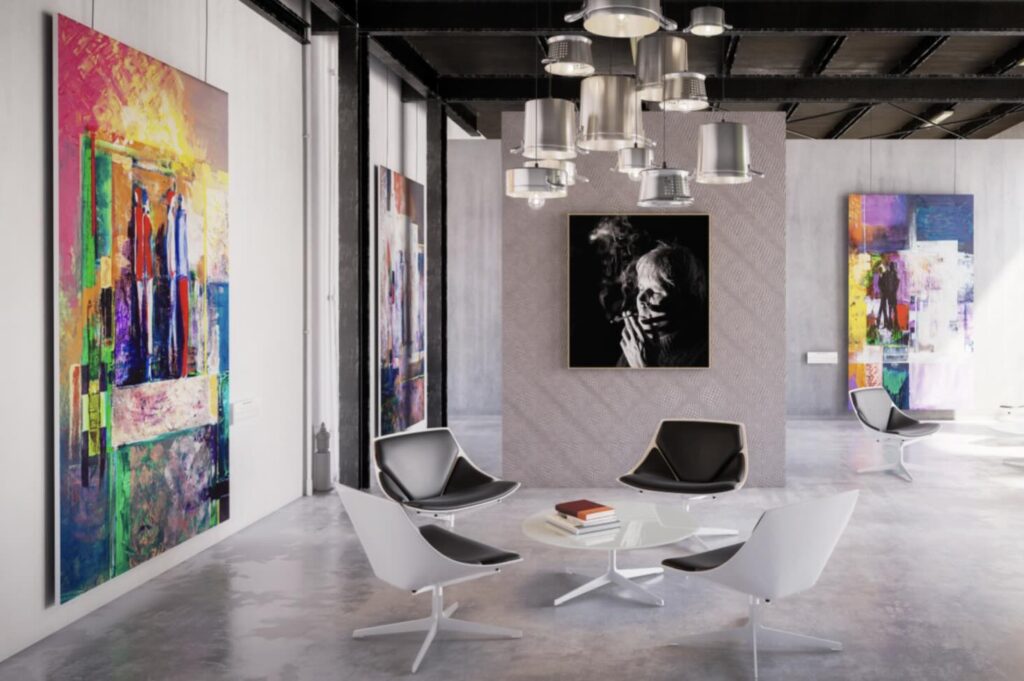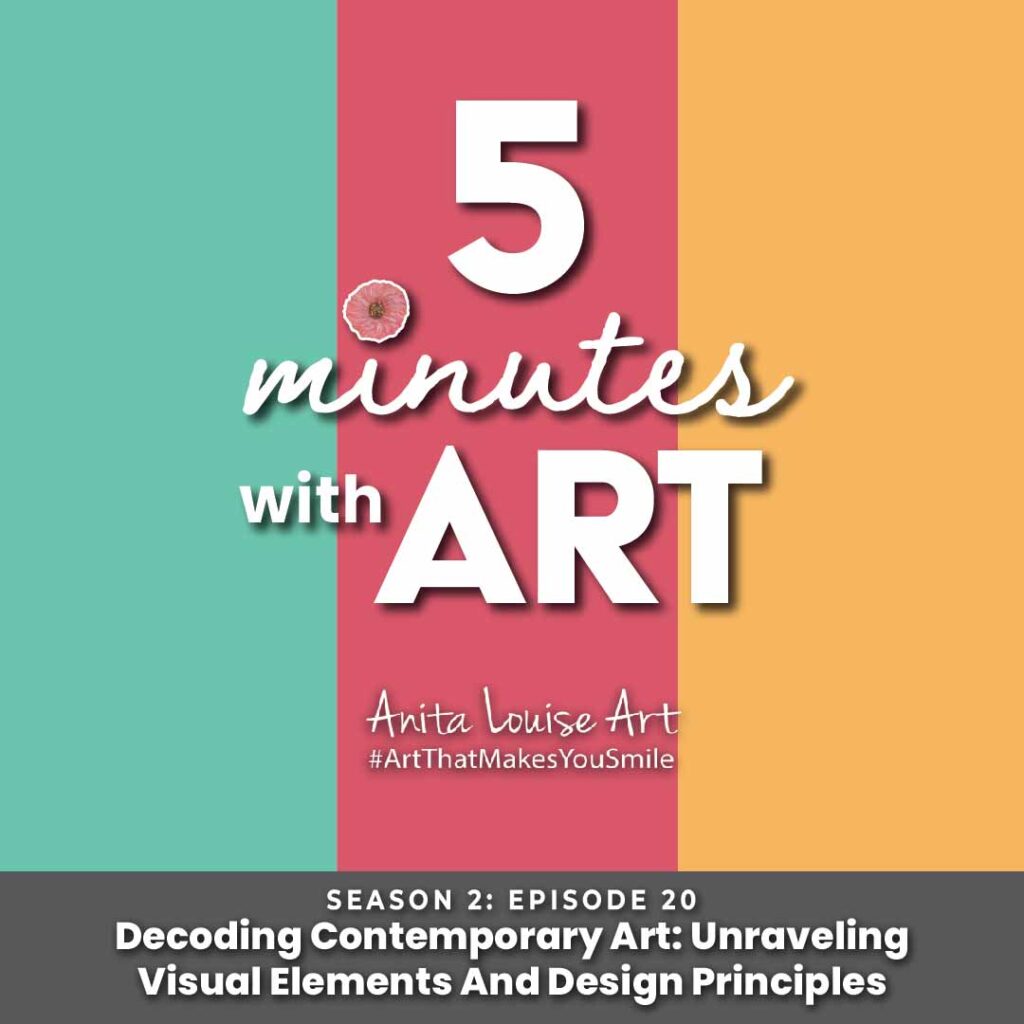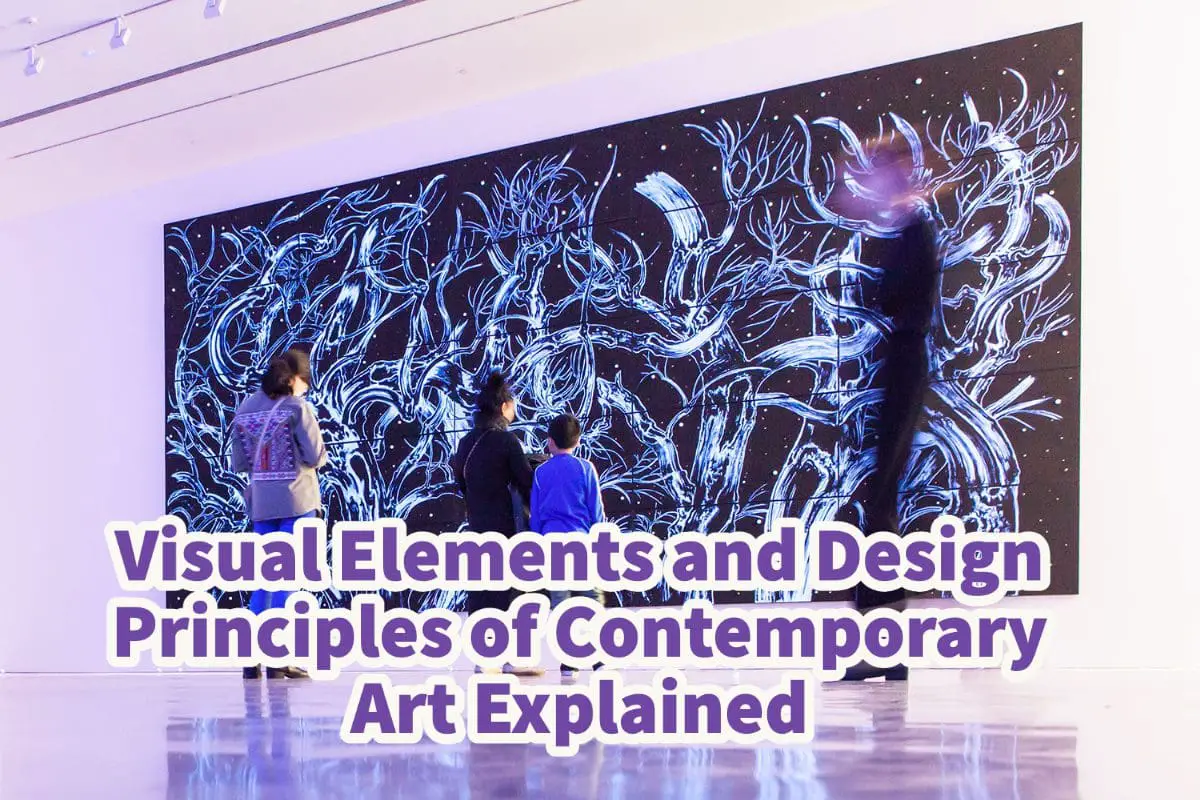One of the important things about art is how the viewer experiences the art. Good artwork creates emotions and feelings for the viewer.
When looking at contemporary art, the visual elements and principles of art and designs should be understood to help the viewer fully understand and immerse themselves in the art. By understanding these principles, the viewer is no longer just viewing the art but has become an active participant.
Table of Contents
- Decoding Contemporary Art: A Guide to Its Visual Elements and Design Principles
- Viewing Contemporary Art
- Frequently Asked Questions
- Related Questions
Decoding Contemporary Art: A Guide to Its Visual Elements and Design Principles
In the realm of art, the interaction between the viewer and the artwork holds paramount importance. Effective art can evoke a spectrum of emotions and feelings in those who engage with it.

Contemporary art, in particular, requires an understanding of its visual elements and foundational design principles to appreciate and immerse oneself in the experience it truly offers. Grasping these principles transforms the viewer from a passive observer to an active participant, deepening the connection with the artwork and enriching the overall experience.”
Many viewers are unsure what to look for when they look at art. They may tell others how the art makes them feel, such as happy or sad, but they may not fully understand the fundamentals of learning to view, speak, and write about art.
To fully understand art, including contemporary art, it is essential to understand the Visual Elements and Principles of Art and Design.
Visual Elements of Contemporary Art
When viewing art, eight essential elements should be considered: line, form, space, shape, color value, and texture. Each of these will help you understand more about the art you are viewing.
Each of these visual elements is explained by:
- Line – A line is an art element formed by a point moving in space. A line can be two or three-dimensional, descriptive, implied, or abstract.
- Form -A form is an element of art that is three-dimensional. The form will include some height, width, and depth, such as a cube, a pyramid, a sphere or a cylinder. A form can also be free-flowing.
- Space – A space is an area of art where both positive and negative areas are defined, and a sense of depth is achieved in the work of art.
- Shape – Shape is the element of art that is two-dimensional, flat or area limited by height and width.
- Color – The color of art is made up of three main color properties as hue, value and intensity. Each of these are:
- Color Hue – This is the name of the color such as red, rose pink indigo.
- Color Value – This is the hue’s lightness or darkness. A color value will change when other colors are added as black and white.
- Color Intensity – This is how bright the color is and how pure the color is as:
- High-Intensity Color – the color is strong and bright
- Low-Intensity Color – the color is light, faint or dull
- Value – Value is the lightness or darkness of the colors. White is the lightest value, and black is the darkest. Between each of these are various color values.
- Texture – Texture is about the ways things look and feel if they are touched. It does it look rough, smooth, or sharp?
All of these are the visual elements that you use when viewing art as contemporary art. All contemporary art usually has all or any of these visual elements. Some of these elements will be prominent, and others not so, but usually, you can find all or most of these visual elements in some way in contemporary art.
When viewing contemporary art, you can think about these visual elements to help you further understand the message the artist’s message.

Principles of Art and Design in Contemporary Art
When viewing art, you also need to look at the principles of art and design. The principles of art and design are how the artist uses the elements in the composition of their artwork.
The essential elements of art and designs are:
- Rhythm – This is a principle of design that indicates movement. The artwork is created with carefully placed elements to create almost a visual tempo, beat or some kind of movement in the work of art.
- Balance – Balance is about combining elements together to give a feeling of equilibrium or even stability in the work of art. Major types of balance are symmetrical and asymmetrical.
- Emphasis – Emphasis is also known as contrast. This is the way of combining elements to stress the difference between the elements.
- Proportion – Proportion refers to the relationship in design between certain elements to each other or the whole.
- Graduation – This is about gradual changes to elements in a design. Examples are large shapes that gradually go to a small shape or hues of color that gradually go from dark to light.
- Harmony – Harmony is about combining similar elements in an artwork to show or accent their similarities. This can be achieved by repetitions or by those subtle, gradual changes.
- Variety – Variety is the design principle concerned with diversity or contrasting area. Variety can be used by using different shapes, sizes, or colors in a work of art.
- Movement – Movement is used in art to create the look and feel of some kind of action. The movement helps to guide the viewers eye through the artwork.
When viewing contemporary art, it helps to understand these principles of art and design principles. Knowing these principles will help you to view and understand art better.
Listen To Our Podcast About Decoding Contemporary Art: Unraveling Visual Elements And Design Principles,
below or by clicking here.

Viewing Contemporary Art
Many contemporary artists use materials from the 20 to 21st centuries that the artist will rework in shocking or exciting ways. This is partly to challenge the critical thinking of art as we know it or to make a statement about art, culture, and society.
When viewing contemporary art, you must think about the visual elements of the art itself and the principles of art and design. You also ask yourself some questions as you are viewing the art.
Some questions you can ask yourself when you are viewing contemporary art:
- What visual elements stand out in this artwork? Why did the artist choose to use those visual elements?
- What principles of art and design did the artist use in their work? How do those principles affect the artwork?
- Is the artwork challenging and interesting? What feeling or thoughts does it evoke when you view it, and why?
- What idea or message is the artist trying to convey and why?
- What kinds of materials and interesting techniques did the artist use in their work? Did the artist transform some ordinary materials and make them extraordinary? How did the artist do this?
- What is the first thing you see when you view the art?
- How does your eye follow around the art?
- How does the artwork touch your senses? What do you see, hear, smell, and feel?
- Does the artist use balance, asymmetry, symmetry, and light/dark to evoke your emotions?
When you understand these principles of art and you start to ask yourself questions when you’re reviewing contemporary art, it will help you in your entire viewing process. You will no longer be an ordinary viewer, but instead, by understanding these elements and principles, you will become an active viewer of contemporary art.
I love Contemporary Art, and many Art Movements inspire me. Anita Louise Art is dedicated to art education, great artists worldwide, and inspiring others to find and create their art. We look for all kinds of art that are made to uplift and inspire. #ArtToMakeYouSmile! #ArtToMakeYouHappy!
Anita Louise Art is dedicated to art education, great artists, and inspiring others to find and create their art. We love art that uplifts and inspires. #ArtToMakeYouSmile! #ArtToMakeYouHappy!
If you are interested to see any of my art, you can find out more by clicking here. If you are interested in what inspires me and my paintings, you can discover more by clicking here.
We have a free newsletter and would love you to be part of our community; you can subscribe to the newsletter by clicking here. If you have any questions, I would be happy to talk to you at any time. You can reach me, Anita, by clicking here.
Subscribe to our Anita Louise Art YouTube Channel filled with great videos and information by clicking here.
Join us for our podcast “5 Minutes With Art.” Spend just 5 minutes a week with us to discover and learn about great art and artists. You can find out more about our podcast by clicking here.
Frequently Asked Questions
What are the elements of visual design in contemporary art?
The elements of visual design in contemporary art typically include line, shape, color, texture, form, and space.
How are the elements of visual design used in contemporary art?
The elements of visual design in contemporary art are used to create a visual language that communicates ideas, emotions, and concepts in a powerful and engaging way.
What are the principles of visual design in contemporary art?
The principles of visual design in contemporary art typically include balance, contrast, unity, rhythm, emphasis, and proportion.
How are the principles of visual design used in contemporary art?
The principles of visual design in contemporary art are used to create a sense of harmony, movement, and visual interest in a piece of artwork.
What is the relationship between the elements and principles of visual design in contemporary art?
The elements and principles of visual design in contemporary art work together to create a cohesive and engaging visual language that communicates a message or idea to the viewer.
How do contemporary artists use color in their work?
Contemporary artists use color in a variety of ways, including to create mood and emotion, to highlight specific elements of a composition, and to convey symbolic or metaphorical meanings.
How do contemporary artists use shape and form in their work?
Contemporary artists use shape and form to create a sense of depth and dimensionality, to emphasize certain elements of a composition, and to create visual interest and movement.
What is the role of texture in contemporary art?
Texture is often used in contemporary art to create a tactile quality to a piece of artwork, to add visual interest and complexity, and to create a sense of depth and dimensionality.
How do contemporary artists use lines in their work?
Contemporary artists use line to create a sense of movement and flow, to define shapes and forms, and to create a sense of depth and perspective.
What is the significance of balance in contemporary art?
Balance is an important principle of visual design in contemporary art, as it helps to create a sense of harmony and equilibrium in a composition.
How do contemporary artists create unity in their work?
Contemporary artists create unity in their work by using elements and principles of visual design in a cohesive and intentional way, creating a sense of harmony and coherence in the composition.
How do contemporary artists use proportion in their work?
Proportion is used in contemporary art to create a sense of balance and harmony, as well as to create a sense of scale and perspective. It is often used to create a sense of realism or to emphasize certain elements of a composition.
Related Questions
How Do Art Movements Begin?
Understanding art movements is not just crucial for the artist but also for anyone interested in art. We can learn many things from the art movements that will help us understand history, art techniques, themes, and how art is created. To truly understand art, we need to understand art movements.
By clicking here, you can learn more by reading How Do Art Movements Begin?.
Why Did New Art Movements Develop In The Years Following World War 1?
Many art movements after World War 1 came about as a direct protest about the devastation and loss of human life in the First World War. These art movements also included cultural and political campaigns where like-minded artists band together to produce satirical and other art.
By clicking here, you can discover more by reading Why New Art Movements Develop In The Years Following World War 1? by clicking here.


